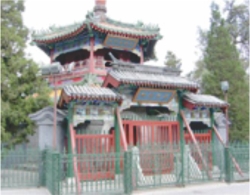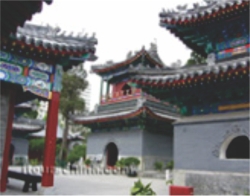| Home - Back Issues - The Team - Contact Us |
 |
| Volume 10 |Issue 28 | July 22, 2011 | |
|
|
Impressions Eid in the
Ox Street Dr Salehuddin Ahmed
The Ox Street Mosque is located in the Southwestern part of Beijing. Beijing has about 80 mosques and this one is the oldest and the largest. Islam was introduced to China during the Tang Dynasty and has followers among more than 10 Chinese ethnic groups including Huis, Uyghurs, Uzbeks and Kazakhs. This mosque was built more than a thousand years ago. Originally, it was built in pure Arabic style of architecture. However, over many phases of reconstruction and renovation, elements of Chinese traditional architecture were adopted. Today, in terms of structure and general layout, Islamic features still prevail. The Mosque was originally built by Nasruddin, the son of an Arabic priest who came to China to preach the Islamic faith in 996 AD (Northern Song Dynasty). Major renovation was carried out in 1442 during the time of Emperor Kangxi (1662-1722) and again after the founding of the People's Republic of China in 1949 when the buildings were entirely repainted and redecorated. Directly inside the front gate stands a hexagonal structure known as the Moon-Watching tower. Every year at the end of Ramadan this tower is repainted and redecorated to signify the celebration of Eid.
We did not get space in the main hall. We sat with many other people on the Courtyard. At 9 a.m. the religious leaders were discussing about Islamic philosophies and teachings over mikes. We could not understand much as it was in Chinese and Arabic. However, with our broken knowledge of Chinese language and some known Arabic expressions, we could realize that they were talking about Islamic values and culture and its teachings and philosophies. At 10 a.m. actual prayers started. We completed our namaaz and then there was khutba in Arabic and Chinese. Finally the 'Munazaat'. Interestingly, the Munazaat was fairly short, may be one minute. Everybody then stood up, started shaking hands and exchange greetings. We also did the same with others. There is no tradition of kolakuli. However, we did our way of kolakuli with some other Bangladeshis who were also attending the prayers. Another old mosque in Beijing is the Dongsi Mosque. Dongsi has been the centre of Islamic culture and events. It houses the Beijing Islamic Association and the Islamic Academy, a good place to appreciate Arabic calligraphy with Chinese influences. Many precious cultural relics are preserved in the mosque. The most precious one is the hand-written copy of the Quran from the Yuan Dynasty. There are also books presented by the Emperor of Egypt. Some other famous mosques in Beijing are: Huashi Mosque, Pushousi Mosque, Fayansi Mosque, Madian Mosque etc. It was a grand celebration of our Eid in Beijing. We thoroughly enjoyed celebrating Eid in this foreign land. Copyright
(R) thedailystar.net 2011 |
 T
T In front of the tower there is a memorial archway and a screen wall covered with carved murals, which together form the main entrance of the Mosque. The congregation takes place in the main hall beyond the entrance. To the rear of the main hall is a group of small religious halls designed in Islamic style. The designs and patterns are composed of Arabic letters and geometric patterns. There are no human or animal figures. Directly in the centre of this section is the minaret, from which the Muezzin says the Azaan. In the inner part of the compound there is a hall marked as “Women's Mosque”. In the large courtyard of the compound there are a number of auxiliary buildings, including classrooms for religious training, offices, and an Islamic research centre. In the Southern part of the compound there is a very large bathhouse used for religious ablutions. We noticed people queuing up for ablutions.
In front of the tower there is a memorial archway and a screen wall covered with carved murals, which together form the main entrance of the Mosque. The congregation takes place in the main hall beyond the entrance. To the rear of the main hall is a group of small religious halls designed in Islamic style. The designs and patterns are composed of Arabic letters and geometric patterns. There are no human or animal figures. Directly in the centre of this section is the minaret, from which the Muezzin says the Azaan. In the inner part of the compound there is a hall marked as “Women's Mosque”. In the large courtyard of the compound there are a number of auxiliary buildings, including classrooms for religious training, offices, and an Islamic research centre. In the Southern part of the compound there is a very large bathhouse used for religious ablutions. We noticed people queuing up for ablutions.